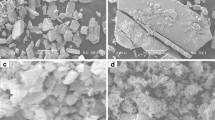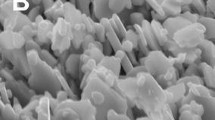Abstract
The formation of MoS2 by thermal decomposition of ammonium tetrathiomolybdate (ATT) solids under an argon atmosphere has been studied by simultaneous thermogravimetric and differential thermal analysis. The sequential products for the decomposition upon heating to 700 °C is ATT (hydrated)→(NH4)2MoS4→(NH4)HMoS4→H2MoS4→MoS3→ Mo2S5→MoS2. MoS2 forms between 230 and 260 °C and remains stable up to about 360 °C when it tends to be oxidized by residual oxygen, if present in the atmosphere. These findings suggest that the synthesis of MoS2 from (NH4)2MoS4 via formation of MoS3 is not a direct process, as previously reported, but rather a complex process involving a number of intermediate products (NH4)HMoS4, H2MoS4 and Mo2S5 which have not been reported before. That these products are only specific to the very narrow temperature regimes as revealed suggests that they are very unstable and short lived, that their presence is transient in nature and thus that ex-situ characterization of them is normally difficult. The presence of these intermediate products, as justified experimentally, is further interpreted in terms of their mutual structural similarities which improve understanding as to why MoS2 can usually be prepared from ATT by thermal decomposition, as in this case, or by other techniques, such as anodizing. Laminar morphology of MoS2 is revealed by transmission electron microscopy and its crystal structure examined by selected-area diffraction. Further ex-situ examination by X-ray photoelectron spectroscopy of this end product supports the feasibility of preparing MoS2 from aqueous solutions by anodizing. © 1998 Kluwer Academic Publishers
Similar content being viewed by others
References
G. A. Tsigdinos, in “Aspects of molybdenum and related chemistry”, edited by G. A. Tsigdinos and G. Moh (Springer, Berlin, 1978) p. 65-105.
E. Y. Rode and B. A. Lebedev, Russ. J. Inorg. Chem. 6 (1961) 608.
G. Guang, Y. Wu, J. Li and H. Liu, Acta Metall. Sin. B6 (1993) 102.
K. Isawa, M. Maejima and K. Sarawatari, New Mater. New Process. B 2 (1983) 420.
A. Muller and E. Diemann, Chem. Berlin 102 (1969) 2603.
J. C. Wildervanck and F. Jellinek, Z. Anorg. Allgem. Chem. 328 (1964) 309.
E. Y. Rode and B. A. Lebedev, Russ. J. Inorg. Chem. 6 (1961) 1189.
H. W. Wang, P. Skeldon, G. E. Thompson and G. C. Wood, J. Mater. Sci. 32 (1997) 497.
P. Skeldon, H. W. Wang and G. E. Thompson, Wear 206 (1997) 187.
G. W. Zhang, J. L. Quang, X. K. Meng, L. Ma, S. G. Qi and F. Zhang, Wear 162–164 (1993) 450.
M. Breysse, R. Frety, M. Lacroix and M. Vrinat, in “Some recent developments in the chemistry of chromium, molybdenum and tungsten”, edited by J. R. Dilworth and M. F. Lappert (Royal Society of Chemistry, Dalton, 1983) p. 11.
R. J. H. Voorhoeve and H. B. M. Walters, Z. Anorg. Allgem. Chem. 376 (1970) 165.
F. Mawrow and M. Nokolow, Z. Anorg. Chem. 95 (1916) 188.
G. Nickless, “Inorganic sulphur chemistry” (Elsevier, Amsterdam, 1968) p. 712.
G. Gattow and A. Franke, Z. Anorg. Allgem. Chem. 352 (1967) 11.
K. Savari, Acta Crystallogr. 16 (1963) 719.
G. Gattow, Naturwissenschaften 46 (1959) 425.
H. W. Wang, P. Skeldon, G. E. Thompson and G. C. Wood, J. Mater. Sci. Lett. 15 (1996) 494.
H. W. Wang, P. Skeldon, G. E. Thompson, Surf. Coat. Technol. 91 (1997) 200.
J. S. Zabinski, T. George and B. J. Tatarchuk, Thin Solid Films 181 (1989) 485.
J. S. Zabinski, M. S. Donley, S. D. Walck, T. R. Schneider and N. T. McDevitt, Tribol. Trans. 38 (1995) 894.
T. A. Patterson, J. C. Carver, D. E. Leyden and D. M. Hercules, J. Phys. Chem. 80 (1976) 1700.
H. W. Wang, P. Skeldon and G. E. Thompson, Surf. Coat. Technol. 88 (1997) 269.
Author information
Authors and Affiliations
Rights and permissions
About this article
Cite this article
Wang, H.W., Skeldon, P. & Thompson, G.E. Thermogravimetric–differential thermal analysis of the solid-state decomposition of ammonium tetrathiomolybdate during heating in argon. Journal of Materials Science 33, 3079–3083 (1998). https://doi.org/10.1023/A:1004335604327
Issue Date:
DOI: https://doi.org/10.1023/A:1004335604327




